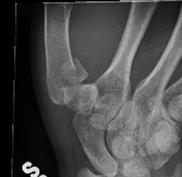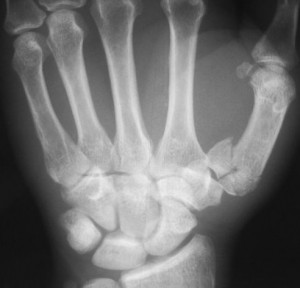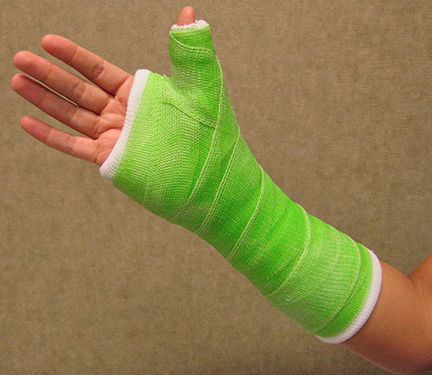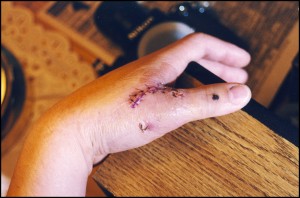
Broken Thumb Injuries Symptoms and Treatment
Broken thumb injuries are highly debilitating and a common cause of thumb pain and hand swelling. Being the shortest finger of a hand, injury to the thumb is less likely. Since, the other fingers face traumatic events earlier and reflex prompt withdrawal keeps the thumb remains relatively safe. Even when falling on the ground, a person tends to injure the wrist or have a dislocated finger more often, compared to the thumb. Also the oppositional movement of the thumb helps us to reflexively conceal it within a fist formed by other fingers and the palm. Thus, getting a broken thumb is not at all easy. However, thumb injuries can cause premature thumb arthritis, which permanently compromises the function of the entire hand.
Importance of Human Thumb
The thumb is an important component of grip due to its oppositional ability (ability to touch all the other fingers of the hand face to face, as in counting with fingers). An oppositional thumb is one of the most important evolutionary gift to man, and makes us unique from all the other animals. The ability of the thumb to help us perform various tasks, like holding, pinching, counting on fingers, writing, and so on, is undoubted. Hence, a thumb injury puts several functional restraints on the entire hand, just as a knee injury disables the entire leg.
Thumb Ligaments and Joints
The thumb contains 2 small bones called phalanges (singular: phalanx), which are connected by the inter-phalangeal joint. The phalanx near the hand or proximal phalanx is connected to the first metacarpal by the metacarpo-phalangeal joint. The ulnar and radial collateral ligaments are present on the sides of both the joints of thumb. Injury to the ulnar collateral ligament of the thumb is common, and is know as Skier’s thumb or Gamekeepers thumb.
Thumb Joint Pain Causes
The reflex concealment of the thumb leaves the metacarpo-phalangeal joint exposed. Also the pressure on the concealed part leads to significant tension on the joint. Hence, thumb injuries are more common near this joint (Picture 1), and lead to partial dislocation or subluxation of this joint along with ligament tears. This is felt as a clicking sensation on pressing over the base of the thumb. This sign of a broken thumb remains positive even months after the injury if orthopedic treatment is not taken. Thus, thumb joint pain is a common sign in majority of thumb injuries !
Types of Thumb Injuries
Thumb injuries can result from fractures or dislocations of the various joints of the thumb.
- Thumb fractures can be of Bennett (Picture 1) or Rolando (Picture 2) type.
- Thumb dislocations can be of the metacarpo-phalangeal (common) or inter-phalangeal type.
- Thumb ligament injuries can be in the form of Skier’s or Gamekeepers thumb

Picture 1: Broken Thumb Injury (Bennett’s Fracture)
(Source: Wikimedia Commons)

Picture 2: Broken Thumb Injury (Rolando Fracture)
(Source: Wikimedia Commons)
Broken Thumb Symptoms
The following are some of the common signs of a broken thumb
- Thumb Joint Pain is the most common among all symptoms of a broken thumb.
- Hand Swelling is a delayed symptom of thumb injury due to insufficient space in the thumb to accommodate the inflammatory fluids.
- Bruised Thumb is mainly due to ligament injury or broken blood vessels in thumb.
- Clicking over base of thumb is due to subluxation of the thumb joint.
- Pain on holding or gripping objects or when attempting to move is a prominent broken thumb sign.
Broken Thumb Video
Can a Broken Thumb get Infected ?
A traumatic injury leads to broken blood vessels in thumb along with inflow of immune cells. The accumulated blood is called a hematoma, which serves as a rich medium for growth of an infection. However, not all people with a broken thumb get infected. Taking a short course of antibiotics after an injury, until the swelling subsides, helps in preventing broken thumb infection.
Broken Thumb Treatment
Thumb, being a vital part of the hand, dictates the necessity to achieve a nearly perfect reconstruction of a broken thumb. Inability to do so may result in functional restraints despite treatment for a prolonged period. Hence, injuries of the thumb are better treated with the expertise of an experienced hand surgeon. Modern surgeries, like thumb joint replacement, and artificial thumb reconstruction, have provided options for treatment of even severely injured thumbs. However, keeping the affected hand elevated from the rest of the body forms an integral part in the care of a swollen broken thumb, since it helps to drain the swelling fluids. This can be done by keeping the hand on a couple of pillows while sleeping and in a sling with hand coming up to the shoulder during the day.
Many times one can get confused about how to find out if your thumb is broken. Except ligament injuries, which require an MRI, all other injuries of the thumb can be diagnosed by a plain X-ray of the hand (Picture 1 & 2). Doubtful cases of thumb injury, where there is a strong suspicion of a fracture, are subjected to a CT scan or bone scan, which picks up even minor hairline fractures. The common protocol, however, is to bring the broken ends of the bones or ligaments to their natural alignment as much as possible, with or without surgery. The next step is to keep them immobilized in this position until the fusion of the broken ends. This process takes around 3-6 weeks, depending on the age of a person (younger people recover early compared to elderly).

Picture 3: Thumb Spica Cast (Fiberglass)
(Source: Queen’s University School of Medicine)
The traditional way to immobilize the thumb was to put a plaster of paris cast from the tip of the thumb reaching right up to the elbow, which is called a thumb spica (Picture 3). This was quite heavy and inconvenient for daily activities. But it is still the recommended method for children, who are not aware of the gravity of the injury and may remove the user friendly options like thumb braces, or thumb splints. Adults on the other hand can be treated with simple and light-weight plastic supports for the thumb, which generally reach up to the wrist. These thumb splints, braces, or supports, come in a wide variety and can also be custom made by molding to fit the right size.
Broken Thumb Surgery
Surgical treatment of the thumb (Picture 4) is reserved for the complete thumb ligament tears and the fractures, which cannot be brought into alignment by closed methods. It involves attachment of the broken structures to each other with the use of orthopedic bone screws and plates or Kirchner’s wires.

Picture 4: Broken Thumb Surgery
(Source: Wikimedia Commons)
However, even after surgery the process of immobilization has to be followed for 3-6 weeks. Physical therapy in the form of thumb and grip strengthening exercises after discontinuation of the thumb spica cast or thumb splint, help in complete bone healing and regaining thumb movements.
2 comments
Peter Macpherson
many years ago I ripped the tendons or ligaments in the web of my thumb. I have full movement in my thumb, but gripping of large piping and other jobs,reminds me of my old injury. I still have a strong hand shake.funnily enough,after all these years the only person who has noticed it,was a two year old boy who was playing with my hand. I know the tendon or ligament is still in there,so at sixty-two I still have a lot of work to do with my hands. My left hand is now showing signs of repetitive strain.
Is there a course of action for my right hand thumb? Thank you..
Jim Delzell
Is there any hand or thumb specific protection to keep the surgical area dry during bathing?